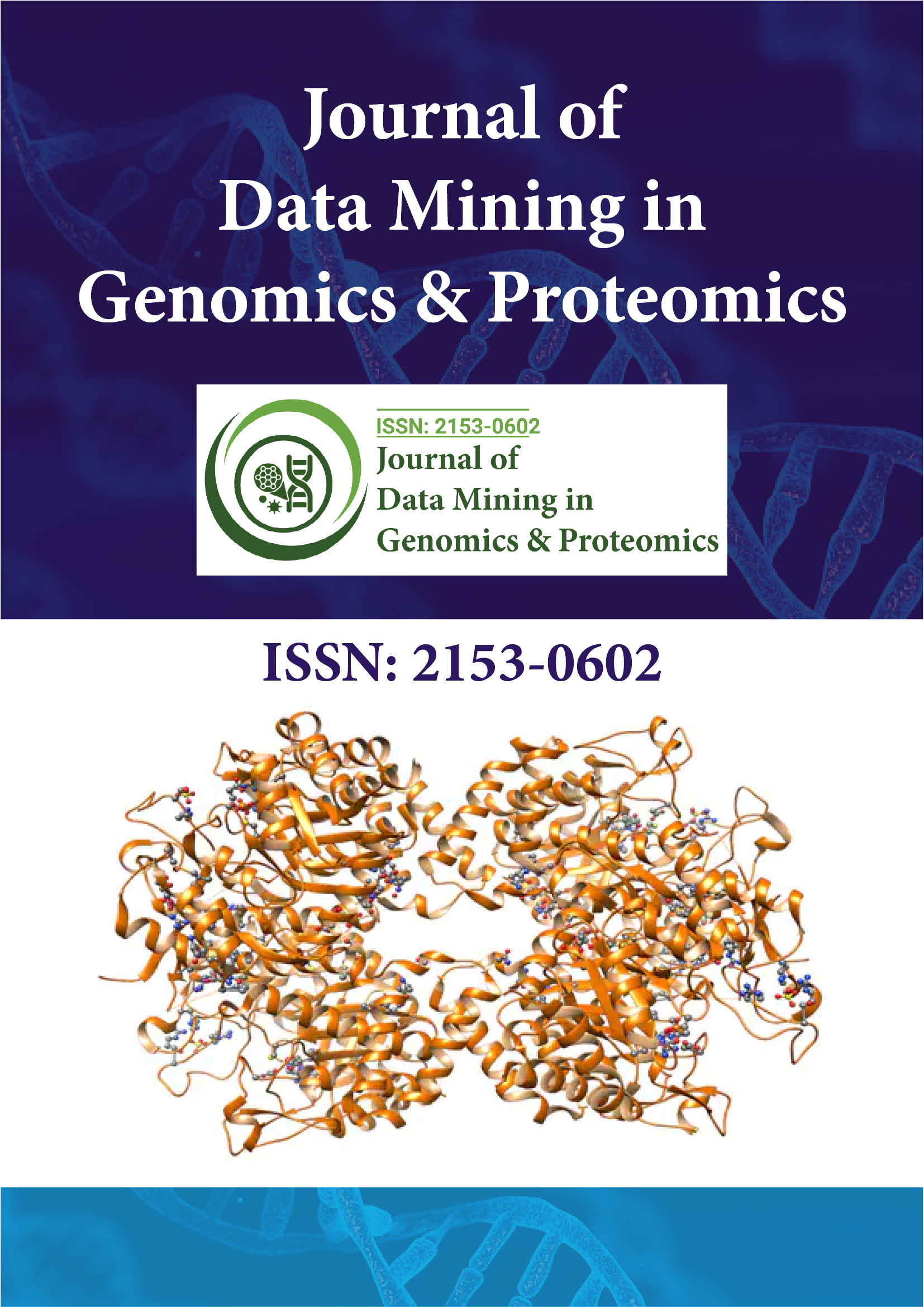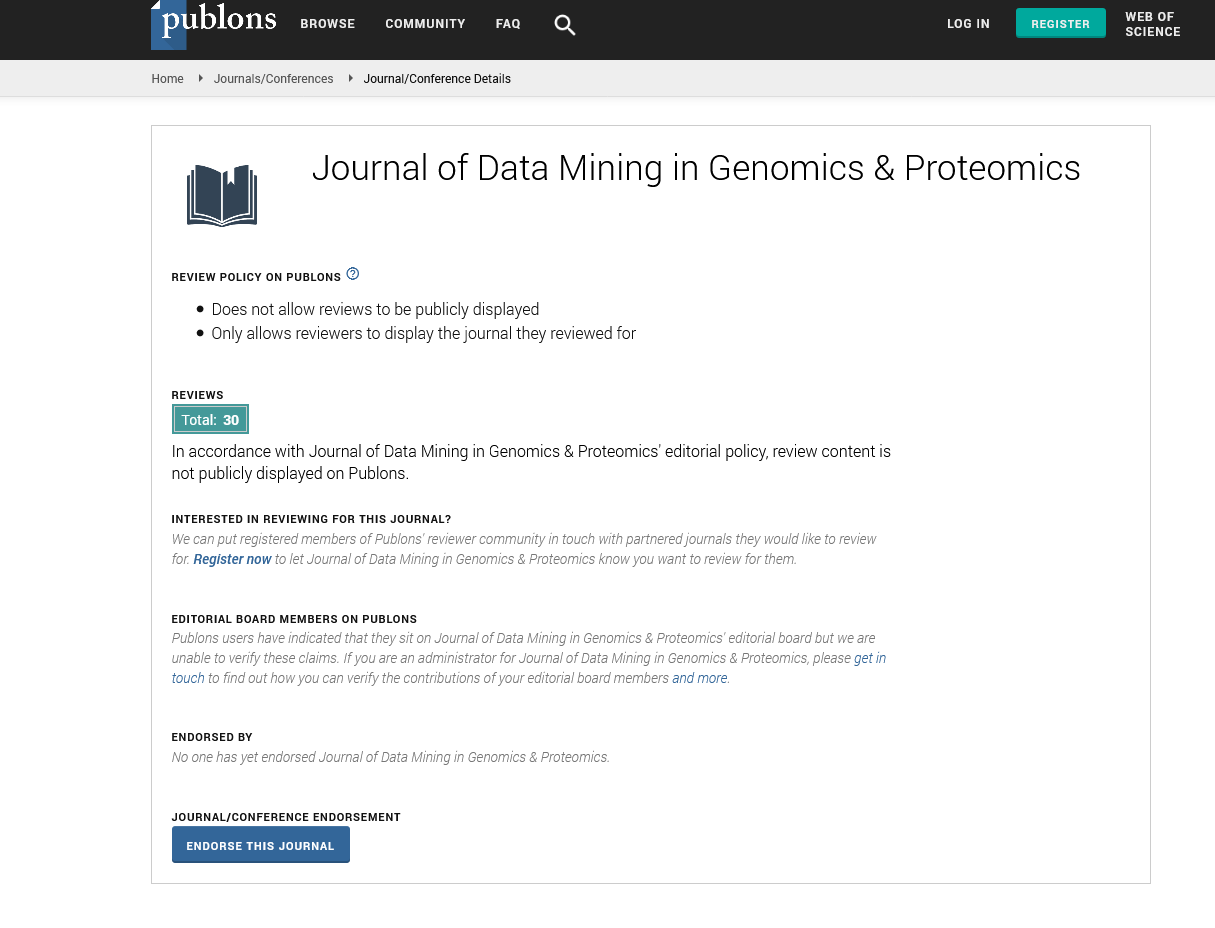Indexed In
- Academic Journals Database
- Open J Gate
- Genamics JournalSeek
- JournalTOCs
- ResearchBible
- Ulrich's Periodicals Directory
- Electronic Journals Library
- RefSeek
- Hamdard University
- EBSCO A-Z
- OCLC- WorldCat
- Scholarsteer
- SWB online catalog
- Virtual Library of Biology (vifabio)
- Publons
- MIAR
- Geneva Foundation for Medical Education and Research
- Euro Pub
- Google Scholar
Useful Links
Share This Page
Journal Flyer

Open Access Journals
- Agri and Aquaculture
- Biochemistry
- Bioinformatics & Systems Biology
- Business & Management
- Chemistry
- Clinical Sciences
- Engineering
- Food & Nutrition
- General Science
- Genetics & Molecular Biology
- Immunology & Microbiology
- Medical Sciences
- Neuroscience & Psychology
- Nursing & Health Care
- Pharmaceutical Sciences
Short Commentary - (2025) Volume 16, Issue 2
Applications of Data Mining in Proteomic Biomarker Discovery
Yuki Matsumoto*Received: 29-May-2025, Manuscript No. JDMGP-25-29759; Editor assigned: 31-May-2025, Pre QC No. JDMGP-25-29759; Reviewed: 14-Jun-2025, QC No. JDMGP-25-29759; Revised: 20-Jun-2025, Manuscript No. JDMGP-25-29759; Published: 28-Jun-2025, DOI: 10.35248/2153-0602.25.16.378
Description
Proteomics has become a central discipline in biomedical research, offering detailed insights into the structure, expression and interaction of proteins within biological systems. Since proteins serve as the primary effectors of cellular processes, their analysis is essential for understanding disease progression and identifying new therapeutic opportunities. Biomarkers derived from proteomic studies play a critical role in diagnosis, prognosis and monitoring of therapeutic responses. However, proteomic experiments often generate large, complex datasets that challenge traditional statistical analysis. This is where data mining approaches have gained significant relevance, providing the means to process massive datasets, extract meaningful patterns and highlight clinically useful biomarkers [1]. One major area where data mining is applied is in cancer research. Mass spectrometry-based proteomics yields thousands of protein expression profiles and discerning which proteins are differentially expressed between healthy and diseased tissues requires sophisticated computational tools. Data mining algorithms enable researchers to filter noise, identify reproducible patterns and classify potential biomarkers associated with tumor growth, invasion and metastasis. For example, clustering methods help group patients based on proteomic signatures, thereby revealing subtypes of cancers that may respond differently to treatment. Such classifications guide personalized therapy and improve outcomes by ensuring that patients receive interventions aligned with their molecular profiles [2].
Proteomic biomarker discovery extends beyond oncology into cardiovascular, neurodegenerative and infectious diseases. In cardiovascular studies, data mining has been used to identify protein signatures associated with myocardial infarction and heart failure. These biomarkers provide clinicians with noninvasive methods to monitor patients at risk and intervene earlier in disease progression. In neurodegenerative disorders such as Alzheimer’s disease, proteomic datasets mined through machine learning have revealed protein aggregates and signaling disruptions linked to cognitive decline. Such findings enhance diagnostic accuracy and inform therapeutic development strategies that address underlying protein misfolding and aggregation [3].
The challenge of biomarker discovery lies in the complexity of proteomic data. Protein expression is highly dynamic, influenced by environmental factors, genetic variation and post-translational modifications. Data mining algorithms must therefore be capable of handling noisy, high-dimensional data while distinguishing true biological signals from experimental artifacts [4]. Feature selection techniques, such as support vector machines and random forest models, have shown considerable success in narrowing down large candidate lists to a manageable number of highly predictive biomarkers. This computational refinement accelerates the transition from discovery to clinical validation. In addition to identifying single biomarkers, data mining has enabled the construction of biomarker panels that provide stronger diagnostic and prognostic power than individual proteins alone [5]. By analyzing correlations and interaction networks, researchers can develop multi-protein signatures that better reflect the complexity of disease biology. Network-based mining approaches have revealed clusters of interacting proteins that act collectively in disease pathways, underscoring the importance of systems-level analysis. Such biomarker panels are increasingly being evaluated in clinical trials for their utility in predicting therapeutic responses and disease progression [6].
Another important application of data mining in proteomics is drug discovery. By comparing proteomic profiles before and after treatment, computational methods can highlight proteins that respond to therapeutic agents. These proteins may serve not only as biomarkers of drug efficacy but also as novel targets for pharmaceutical development. Integrating proteomic data with transcriptomic and metabolomics layers further strengthens drug discovery pipelines, ensuring that therapeutic strategies are grounded in a holistic view of biological function [7]. The growing application of artificial intelligence and deep learning in proteomics promises to refine biomarker discovery even further. These methods can detect nonlinear relationships and complex patterns that traditional algorithms may overlook. However, issues of interpretability, reproducibility and data standardization remain challenges to be addressed. Collaborative efforts across institutions and the development of standardized data-sharing platforms will be essential for ensuring that computational findings translate effectively into clinical utility [8].
As proteomics continues to advance, data mining will remain a powerful tool for extracting actionable insights from complex datasets. By enabling the discovery of reliable biomarkers across diverse diseases, computational strategies are strengthening diagnostic capabilities and enhancing the precision of therapeutic interventions. The integration of proteomics and data mining is paving the future of personalized medicine, where treatments are informed by deep molecular understanding rather than generalized clinical indicators [9]. Moreover, as new proteomic technologies emerge such as single-cell proteomics and spatial proteomics they are expanding the resolution at which proteins can be studied within tissues and individual cells. These innovations, combined with advanced data mining, will allow researchers to capture the heterogeneity of disease at unprecedented levels. Understanding how protein expression varies not only between patients but also across cell types and microenvironments will refine the classification of disease subtypes and inform the development of next-generation therapies. Ultimately, the fusion of cutting-edge proteomic techniques with intelligent data analytics will drive transformative advances in biomedical research and clinical care [10].
References
- Hermann J, Schurgers L, Jankowski V. Identification and characterization of post-translational modifications: Clinical implications. Mol Asp Med. 2022;86:101066.
[Crossref] [Google Scholar] [PubMed].
- Cozzolino F, Landolfi A, Iacobucci I, Monaco V, Caterino M, Celentano S, et al. New label-free methods for protein relative quantification applied to the investigation of an animal model of Huntington Disease. PLoS one. 2020;15(9):0238037.
[Crossref] [Google Scholar] [PubMed].
- Zhang W, Sakashita S, Taylor P, Tsao MS, Moran MF. Comprehensive proteome analysis of fresh frozen and Optimal Cutting Temperature (OCT) embedded primary non-small cell lung carcinoma by LC–MS/MS. Meth. 2015;81:50-55.
[Crossref] [Google Scholar] [PubMed].
- Dapic I, Uwugiaren N, Jansen PJ, Corthals GL. Fast and simple protocols for mass spectrometry-based proteomics of small fresh frozen uterine tissue sections. Anal Chem. 2017;89(20):10769-10775.
[Crossref] [Google Scholar] [PubMed].
- Zhao X, Huffman KE, Fujimoto J, Canales JR, Girard L, Nie G, et al. Quantitative proteomic analysis of Optimal Cutting Temperature (OCT) embedded core-needle biopsy of lung cancer. J. Am. Soc. Mass Spectrom. 2017;28(10):2078-89.
[Crossref] [Google Scholar] [PubMed].
- Sun H, Poudel S, Vanderwall D, Lee DG, Li Y, Peng J. 29â?Plex tandem mass tag mass spectrometry enabling accurate quantification by interference correction. Prot. 2022;22(19-20):2100243.
[Crossref] [Google Scholar] [PubMed].
- Thompson A, Schäfer J, Kuhn K, Kienle S, Schwarz J, Schmidt G et al. Tandem mass tags: A novel quantification strategy for comparative analysis of complex protein mixtures by MS/MS. Anal chem. 2003;75(8):1895-1904.
[Crossref] [Google Scholar] [PubMed].
- Koomen JM, Haura EB, Bepler G, Sutphen R, Remily-Wood ER, Benson K, et al. Proteomic contributions to personalized cancer care. Mol. Cell. Proteom. 2008;7(10):1780-94.
[Crossref] [Google Scholar] [PubMed].
- Whitelegge JP, Katz JE, Pihakari KA, Hale R, Aguilera R, Gómez SM, et al. Subtle modification of isotope ratio proteomics; an integrated strategy for expression proteomics. Phytochem. 2004;65(11):1507-1515.
[Crossref] [Google Scholar] [PubMed].
- Luo H, Ge H. Application of proteomics in the discovery of radiosensitive cancer biomarkers. Front Oncol. 2022;12:852791.
[Crossref] [Google Scholar] [PubMed].
Citation: Matsumoto Y (2025). Applications of Data Mining in Proteomic Biomarker Discovery. Journal of Data Mining in Genomics & Proteomics. 16:378.
Copyright: © 2025 Matsumoto Y. This is an open-access article distributed under the terms of the Creative Commons Attribution License, which permits unrestricted use, distribution and reproduction in any medium, provided the original author and source are credited.

